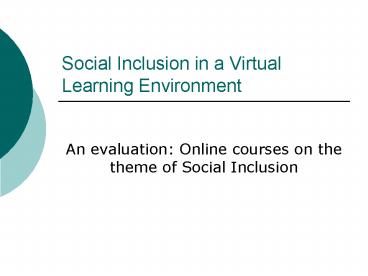Social Inclusion in a Virtual Learning Environment - PowerPoint PPT Presentation
1 / 18
Title:
Social Inclusion in a Virtual Learning Environment
Description:
The process of the project. Theory background. Social Inclusion. What is Social Inclusion ... The using of Social Inclusion in VLE ... – PowerPoint PPT presentation
Number of Views:40
Avg rating:3.0/5.0
Title: Social Inclusion in a Virtual Learning Environment
1
Social Inclusion in a Virtual Learning Environment
- An evaluation Online courses on the theme of
Social Inclusion
2
The process of the project
Evaluation
Unit 1
Piloting
Designing unit 1
Final Report
Unit 2
Testing
Evaluation
Unit 3
3
Theory background
- Social Inclusion
- What is Social Inclusion
- Why Social Inclusion
- Critique and contradictions in Social Inclusion
- Teaching and learning in VLE
- Distance learning students
- Three components of learning
- Students self-regulation
- Journal writing and self-reflection
4
Module 1 What is Social Inclusion
Unit 1 Philosophy
Unit 2 Values
Unit 3 Collaboration
What is social Inclusion?
What does Collaboration Mean?
Theories
Values and Attitudes
Philosophical Perspective
Different Perspectives
Power
Bromfenbrenner (Micro-Macro)
Theories of Collaboration
Assessment
Assessment
Assessment
5
The piloting of unit one
- The Scottish group 9 students 2 tutors
- The Icelandic group 8 students 2 tutors
- Evaluation built on
- Online discussion about subjects
- Student journals
- Meetings of each countries group
- Evaluation meeting in the Virtual Classroom
6
The evaluation
- The material was examined in relation to
- Knowledge
- Reflection, values and attitudes
- Interactive discussion
- Technical matters
7
Evaluation findings
- In relation to knowledge
- Learning about lives of people in each others
country was interesting - The subject matter was relevant
8
Evaluation findings
- In relation to values and attitudes
- The course had changed their thinking
- They had learned to value others views
- They had reflected on being equal in society and
in this group - The process of thought being encouraged by the
cultural differences
9
Evaluation findings
- In relation to interactive discussion
- People were very friendly towards each other
- Reacting and commenting on each others input in
the discussion was not common
10
Evaluation findings
- In relation to technical matters
- Blackboard was not difficult, even for those with
little confidence in computer literacy
11
Evaluation of findings
- Views on the organisation of the unit were
diverse - Some wanted more framework
- Others did not
- One student said
- That sounds like another module then
12
Findings and thoughts taken into the making of
unit 3
- More focus on affective and reflective goals
- Using little text and giving students opportunity
to choose interesting reading material - The use of pictures, visual literacy
- The possibilities of using the course with
in-service preschool staff
13
Conducting Unit three
- Using pictures
- Using little text
- Encouragement to connect to theory and practice
- Students self-control
- Students co-construction
- Creating environment for self-control, reflection
and requirements
14
Unit three - Collaboration
15
Evaluation findings unit two and three
- Participants
- Two students and two teachers from Scotland
- Two students and two teachers from Iceland were
guests in the course
16
Evaluation of pre-test unit two and three
- Findings
- Using Blackboard was not a problem
- Difficult to come into a group which had already
started - Working with values and attitudes was complicated
but interesting - Using pictures and students choosing reading
material was appealing - Possibility of using the course with groups of
staff from preschools
17
Questions put forward
- Does the use of technology change the process of
learning? - How do the students manage to use the
organisation of the course in relation to three
aspects of teaching and learning? - Does the use of technology change the teachers
methods? - How does Social Inclusion, affect the process of
learning?
18
Conclusions
- The using of Social Inclusion in VLE
- The concept is broad and has many meanings and
the critiques say it is full of contradictions - Why do we need to encourage students
self-reflection? - Social Inclusion has it!
- Changing teaching and learning methods
- It takes two! Teachers and learners
- Problems, technical, organizational, personal
- Students self-control and self-reflection through
journal writing.































